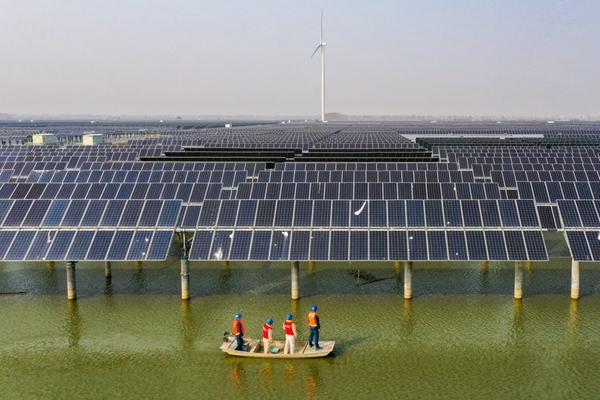Strides made in greenhouse gas reduction
 0 Comment(s)
0 Comment(s) Print
Print E-mail China Daily, September 15, 2023
E-mail China Daily, September 15, 2023

Aerial photo taken on Nov. 3, 2021 shows electricity workers patrolling amid a photovoltaic and wind power generation project installed above the fishery waters in Sheyanghu Township of Baoying County of Yangzhou, east China's Jiangsu Province. [Photo/Xinhua]
China's efforts to phase out ozone depleting substances from 1991 to 2020 avoided emissions of greenhouse gases equivalent to 26 billion metric tons of carbon dioxide, Zhao Yingmin, vice-minister of ecology and environment, said on Thursday.
China has phased out roughly 628,000 tons of ozone depleting substances, which represent over half of the contributions made by developing nations, he said at an event to celebrate World Ozone Day, which falls on Sept 16 every year.
China has also made remarkable progress in reducing hydrofluorocarbons — a type of greenhouse gas that is more potent than carbon dioxide, as the nation strives to implement the Kigali Amendment to the Montreal Protocol on Substances that Deplete the Ozone Layer.
Reached in 2016, the Kigali Amendment aims to gradually reduce the consumption and production of HFCs based on the consensus that they are powerful greenhouse gases.
Given their zero impact on the depletion of the ozone layer, HFCs are used as replacements for some substances that have such an effect.
China has this year accomplished data verification in the HFCs sector and worked out a plan to cap the production and consumption of such substances and distribute the allowances in 2024, said Zhao.
He said China is to fully implement an allowance-based HFCs management mechanism to ensure the country can realize its HFCs control target next year.
Beate Trankmann, resident representative of the United Nations Development Programme in China, said the ozone layer is now healing, thanks to the collective efforts made by the international community after the Montreal Protocol — a global agreement the world adopted 35 years ago to phase out the production of harmful chemicals to protect the ozone layer.
Indeed, the latest update from the Scientific Assessment Panel to the Montreal Protocol confirmed that ozone levels over the Antarctic are expected to return to 1980 levels by around 2066, she stated.
According to experts, the phaseout of greenhouse gases as part of efforts to implement the Montreal Protocol has helped to avert an additional increase in global average surface temperature of as much as 2.5 C by the end of the century, she continued.
"China has made important contributions to these efforts through project implementation, policy formulation, strong enforcement of regulations and public awareness raising," she said.
As the world's leading country in the production, consumption, import and export of HFCs, China's ratification of the Kigali Amendment was critical and has helped to energize global efforts to reduce emissions, she continued.






Go to Forum >>0 Comment(s)